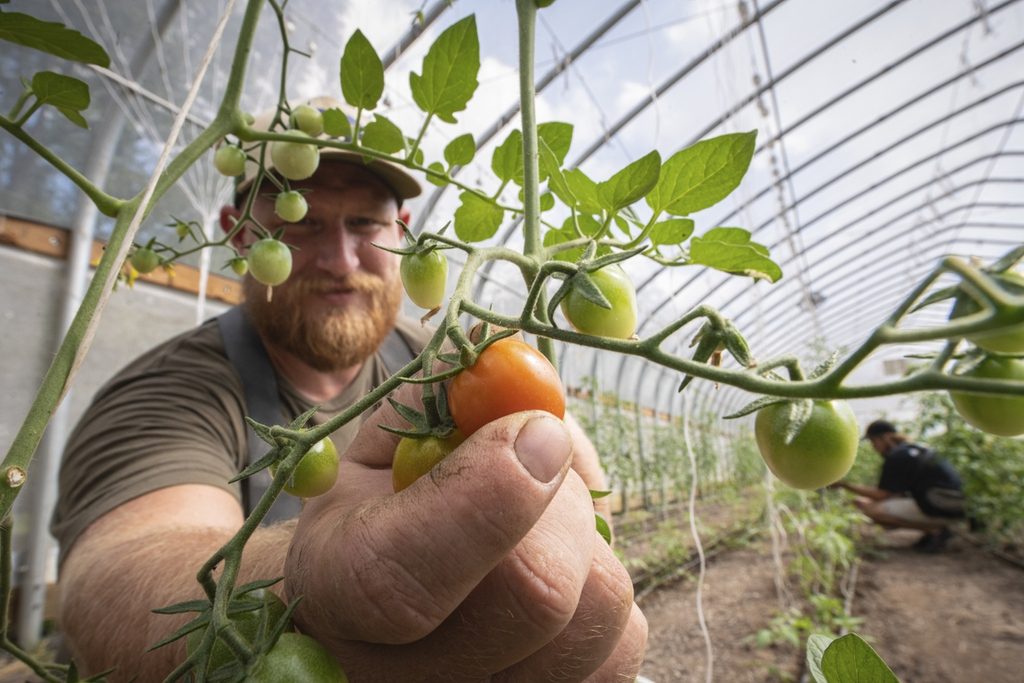Do you want to know how to advance your horticulture career so that you can reach your dream job, whether that’s in management, in a garden design capacity, or on the tools?
You might not be a good fit for your dream job right now, but that doesn’t mean you should wait to apply. You never know, you might get accepted.
But just in case you aren’t accepted, you should apply for other jobs you’re already qualified for, and work on becoming a stronger candidate in the meantime.
Understanding the Different Career Paths in Horticulture
Horticulture is a vast and dynamic field that offers a range of career paths for individuals interested in working with plants, gardens, and landscapes. Whether you’d like to manage large commercial greenhouses, design residential gardens, or climb trees to inspect them, there’s a career path for you in horticulture.
Check out this article to read about 26 horticulture-related careers for inspiration.

What’s your dream horticulture job? Image source
Identifying Your Goals and Aspirations for Your Horticulture Career
Identifying your goals is an essential step towards reaching your dream horticulture job. Think about what type of work you enjoy and what you want to achieve in your career. Consider factors such as job satisfaction, job security, and salary when setting your goals.
What skills and qualifications will you need to obtain, and do you have any way to get your foot in the door?
Once you have a clear understanding of your aspirations, you can start to develop a plan for how to reach them.
Find Horticulture Jobs to Apply to
Browse job boards and build a list of jobs you’d like to apply to. Hort People is the Australian horticulture industry job board, and has over 60 categories to choose from including design, construction, maintenance, production, retail, sales, admin and much more.
Click here to browse jobs and categories.
You can also find jobs through your network and social media.
Understanding the Job Market Trends and Salary Expectations in Horticulture
The horticulture industry in Australia is currently facing a shortage of skilled workers, and this trend is expected to continue in the coming years. This has forced some employers to raise wages above the award. Hort People makes employers post a mandatory salary range on all job advertisements to help you keep track of these trends.
Click here to browse jobs with salaries.
Pay attention to the way the industry is moving away from chemical reliance and into Pest Integrated Management (IPM) strategies. Notice how the emphasis is on planting the right plant in the right place, which takes a lot more training and experience than planting whatever looks pretty.
By staying informed on the latest industry trends, you can make informed decisions about your career goals and how to best achieve them.
Building Your Professional Reputation and Making a Name for Yourself
With every interaction you have with your superiors, co-workers, clients, and other professionals in the industry, you’re building your reputation.
What do you want to be known for? Are you highly knowledgeable in your field? Do you have a unique garden design style? Are you able to perform decent work quickly?
Either way, act with integrity at all times, because what people say about you can make or break your career.
Benefits of a Strong Online Presence for Horticulture Job Seekers
Having a strong online presence can greatly benefit horticulture job seekers in several ways. Some of the key benefits include:
- Increased Visibility: An online presence makes you more visible to potential employers, especially through professional networking sites like LinkedIn, where hiring managers may be searching for candidates online. Twitter, Instagram and even Tik Tok are also potential platforms to attract your next boss.
- Professional Branding: A strong online presence can help you build your professional brand and showcase your personality, skills, and achievements. By creating a professional profile, you can demonstrate to employers why you’re the best candidate for the job.
- Networking Opportunities: By being active on social media, you can connect with other professionals in your field and build valuable relationships. This can help you learn about new job opportunities and stay up-to-date on industry trends.
Keep in mind that employers may search your social media profiles even if they aren’t in your application, so put your personal Facebook page on private.
Making the Most of Industry Associations and Industry Events
One way to increase your chances of landing a job in the horticulture industry is to get involved with industry associations and attend industry events. Industry associations are groups of professionals in a particular field who come together to share information, resources, and support.
Industry events help you meet potential employers, learn about the latest industry trends, and gain new skills and knowledge to make you more employable. You can also take advantage of the opportunities to connect with other job seekers and learn about potential job openings.

Industry events are a great place to network. Image sourece
How to Highlight Your Uniqueness for a Horticulture Job
Your old resume probably wasn’t very good, so don’t worry if you need to start again from scratch.
Consider what sets you apart from others. Make a list of all your qualifications, skills, and experiences that relate to the role. This could include education, certificates, volunteer work, internships, or on-the-job training. You may also want to consider any specialties you have, such as expertise in a specific type of plant or garden design.
Next, think about how you can showcase these qualifications on your resume. This might involve creating a skills section that emphasises your unique abilities, or highlighting specific accomplishments in your work history. Consider using keywords that are relevant to horticulture and the job you’re applying for. For example, if you have a chemical spray ticket, make sure to include that in your resume. You can also consider creating a portfolio or website that showcases your work and qualifications.
Remember, your goal is to make your resume stand out and show prospective employers why you’re the best fit for the job. So, be creative, be specific, and highlight your unique qualifications in a way that showcases your passion and expertise in horticulture.
Creating a Standout Horticulture Resume
A well-written, polished, and professional resume can give you an edge over other applicants and showcase your skills and qualifications.
Your horticulture resume should be tailored to the specific job you’re applying for, just like your cover letter. You’re better off sending a few targeted resumes than sending spam to 100 employers.
Read this article for 17 ways to boost your horticulture and landscape resume.
Common Mistakes to Avoid When Writing a Horticulture Resume
Here are some of the most common resume mistakes to avoid:
- Failing to Tailor Your Resume to the Job: As mentioned above, a one-size-fits-all approach to your resume is unlikely to impress a potential employer.
- Neglecting Keywords: Some employers use applicant tracking systems (ATS) to screen resumes. Make sure your resume includes the keywords that are relevant to the job you’re applying for, as employers may not even see your application if it doesn’t include these keywords.
- Providing Too Much Information: While it’s important to provide enough information to demonstrate your qualifications and experience, a resume that’s too long or detailed can be overwhelming and confusing. Stick to the most important information and be concise and clear.
- Making Grammatical or Typographical Errors: A resume that’s full of grammatical errors will make a poor impression on potential employers. Proofread your resume thoroughly, and use software like ProWritingAid or Grammerly to check your work (not affiliated).
- Lack of focus: Your resume should be concise and targeted towards the specific job you’re applying for. Avoid including irrelevant information or details that don’t pertain to the horticulture field.
- Incorrect format: Choose a format that’s easy to read and professional. Make sure your resume is well-structured, with clear headings and bullet points.
- Typos and grammatical errors: These are simple mistakes that can make a huge impact on your chances of landing an interview. Be sure to proofread your resume several times before submitting it.
- Failing to quantify your accomplishments: Whenever possible, include specific numbers, data, and examples of your accomplishments in your resume. This helps to illustrate your skills and experience more effectively.
- Not tailoring your resume to the job description: It’s important to tailor your resume to each job you apply for by highlighting the skills and experience that are most relevant to the position.
The Importance of a Professional and Attractive Resume Design
A professional and attractive resume design can have a significant impact on your chances of landing a job in the horticulture industry.
Aesthetics are highly valued in our industry, so this is an easy way to set you apart from other candidates. Not only will it reflect your attention to detail and level of professionalism, but it can also make you more memorable to hiring managers, increasing your chances of landing your dream horticulture job.
How to Make Your Horticulture Resume Stand Out with Keywords
The job description you’re applying to will contain certain keywords and terms, including specific skills, software, or certifications that are required for the position. Incorporate these keywords into your resume in a natural and relevant way.
Make sure to use these keywords in your professional summary, work experience, and education sections. In your work experience section, highlight your achievements and accomplishments using keywords. For example, if you have experience with a specific type of horticulture equipment, mention it in your work experience section.
It’s also a good idea to use keywords in your resume’s title, if possible. This will make it easier for recruiters and hiring managers to find your resume when they search for candidates who have the skills and experience they’re looking for.
When using keywords in your resume, it’s important to avoid keyword stuffing, or using keywords excessively. This can come across as inauthentic and could harm your chances of getting noticed.
Tips for Writing a Strong Cover Letter
Along with your resume, your cover letter is part of your first impression with employers. It’s a chance to showcase your qualifications and passion for the field, not something to rush through and send prematurely.
Here are some tips to help you write a strong cover letter for your horticulture job application:
- Research the Company: Before writing your cover letter, research the company and the specific job you are applying for. Look for information to help tailor your letter and demonstrate your understanding of the company and their clients.
- Address the name in the job description: Personalise your cover letter by addressing the hiring manager if it’s displayed in the job description. This shows that you’ve taken the time to actually read the job ad and demonstrates your genuine interest.
- Highlight Relevant Skills and Experiences: Use your cover letter to provide real-life examples of how your specific skills and experiences make you a strong fit for the job. Focus on what’s most relevant to the horticulture job you’re applying for.
- Show Passion for Horticulture: Let your passion for horticulture shine through in your cover letter. Explain why you’re drawn to the field and what you hope to contribute to the company.
- Keep it Short and Sweet: Your cover letter should be brief and to the point, no longer than one page. Highlight specific examples and expand upon your resume, rather than repeating information from it.
How to Ace Your Horticulture Job Interview
Preparation is key to making a great first impression and highlighting your qualifications and enthusiasm for the role, as we’ve discussed in this article. Here are some best practices to keep in mind when preparing for a horticulture job interview:
- Research the company: Learn about the company’s values, and the types of clients they work for. As with your resume and cover letter, this will give you a better understanding of the organisation and help you tailor your responses to the specific needs and expectations of the role.
- Review the job description: Familiarise yourself with the responsibilities and requirements of the position. This will help you to prepare specific examples of how your skills and experience align with the job requirements.
- Practice your answers: Prepare responses to common interview questions such as “Why do you want to work for this company?” and “What is your experience with (specific aspect of the role)?”
- Dress appropriately: It’s usually best to dress professionally for a job interview, even if the role would have you in workwear. Wear a button-up shirt, long pants, a skirt or dress and a pair of nice shoes. This shows that you’re taking the interview seriously and demonstrates your respect for the company.
- Be on time: Arriving on time for your interview shows that you’re reliable and punctual, which are important qualities for any horticulture role.
- Be confident: Remember to take deep breaths, relax, and be confident in your abilities and qualifications. Show your enthusiasm for the role and the company, and be ready to answer questions with clear, concise, and thoughtful responses.
Following Up
Following up after a horticulture job interview is an important step in the job search process. It shows your continued interest in the position and can also provide you with additional insights into the company and their hiring process.
Send a thank you email to the interviewer(s) within 24 hours of the interview, while it’s still fresh in their mind. This can be a short, personalised message that expresses your gratitude for the opportunity to meet and reiterates your interest in the position.
Check in with the hiring manager or HR representative a week after the interview to inquire about the status of the hiring process. This can be a polite email or phone call that shows your continued interest in the role.
It’s important to give the hiring team enough time to make a decision, but not so much time that they forget about you.

Put your best foot forward. Image source
Seeking Out Opportunities for Professional Development and Growth
While you’re at your current job, look for ways to become more hireable for your future dream horticulture job.
Many employers offer training programs and professional development opportunities for their employees. This can include in-house training sessions, tuition reimbursement, and opportunities to attend conferences and workshops.
You can ask to be trained in certain machinery, or ask to shadow a co-worker while they perform a task you’ve never done before.
Building Your Portfolio
A career portfolio is a collection of documents and materials that showcase your skills, achievements, and experiences in your chosen field.
Include photos and descriptions of the horticultural projects you’ve worked on, including the scope of work, the techniques used, and the final outcome. Make sure to highlight the skills and techniques you used and the results you achieved.
Your portfolio should be visually appealing and well-organised, with clear headings and an easy-to-follow structure. Use high-quality images, colour, and typography to make your portfolio stand out and effectively showcase your work.
Seeking Out Opportunities for Mentorship and Professional Development
By seeking out opportunities for mentorship, you can learn from experienced professionals who’ve already navigated the challenges and opportunities of the horticultural industry. This can give you a valuable perspective on your own career goals, and help you develop the skills and knowledge you need to achieve them.
Mentorships usually develop naturally when you’re consistently putting yourself in a position to learn from people who’ve done the sorts of things to what you want to achieve. However, they can be organised through your employer.
Conclusion
Rome wasn’t built in a day. If you start putting the work in now, you’ll be able to prepare for your dream job in the future. All you need is passion to do the work, a plan to get you there, and the patience to work in a less-than-perfect job in the meantime.

One Comment
[…] a job in your chosen field of horticulture. You need to learn how to write a compelling resume and cover letter, networking with industry professionals, and make the most of job fairs and other […]